The 1985 Volkswagen Vanagon, a symbol of freedom and exploration, holds a special place in automotive history. This iconic van, with its boxy design and unmistakable charm, captivated the hearts of adventurers, families, and surfers alike. Its popularity soared in the United States, becoming synonymous with the spirit of the 1980s.
The Vanagon’s versatility was unmatched. It effortlessly transformed into a mobile home, a rugged off-roader, or a stylish city cruiser. Its spacious interior, pop-up roof, and sliding doors offered a sense of openness and practicality that resonated with a generation seeking adventure.
From camping trips in national parks to surfing expeditions along the California coast, the Vanagon became a trusted companion for countless journeys.
The Vanagon’s Legacy
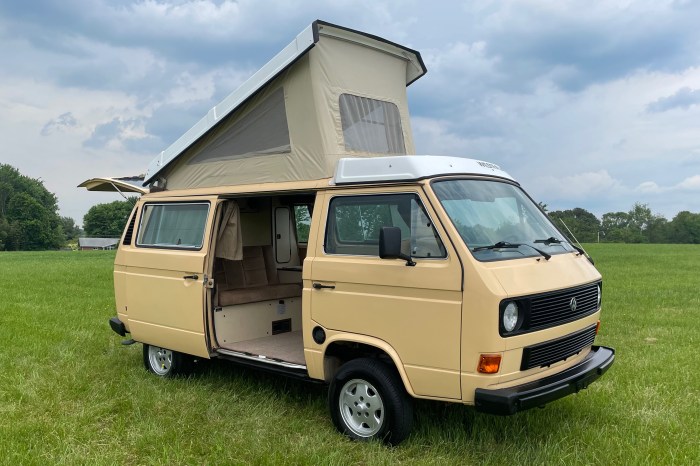
The 1985 Volkswagen Vanagon, a successor to the iconic Transporter (T1 and T2), holds a significant place in automotive history, particularly for its enduring appeal and cultural impact, especially in the United States. Its unique blend of practicality, versatility, and a certain “free-spirited” charm resonated with a generation seeking adventure and a simpler way of life.
The Vanagon’s Popularity and Cultural Impact
The Vanagon’s popularity was fueled by its versatility and affordability. It offered a spacious interior, easily converted into a camper, a mobile home, or a vehicle for hauling cargo. Its air-cooled engine, while not always the most efficient, provided a sense of reliability and ease of maintenance.
The Vanagon’s rugged design and high ground clearance made it ideal for off-road adventures, and its iconic “bus” silhouette became synonymous with the spirit of freedom and exploration.
- Camping:The Vanagon’s spacious interior, removable seats, and available pop-up roof made it a natural choice for camping enthusiasts. The van could easily accommodate a family or a group of friends, providing a comfortable and mobile base for exploring the great outdoors.
- Surfing:The Vanagon’s spacious cargo area and roof rack were perfect for transporting surfboards, making it a favorite among surfers. The van’s rugged construction and all-wheel-drive option allowed surfers to reach remote beaches and enjoy the waves.
- Family Travel:The Vanagon’s practicality and versatility made it an ideal vehicle for families on the go. Its spacious interior, ample cargo space, and comfortable seating allowed for long road trips and weekend getaways. Its reliability and ease of maintenance made it a dependable companion for families on the road.
Design and Features
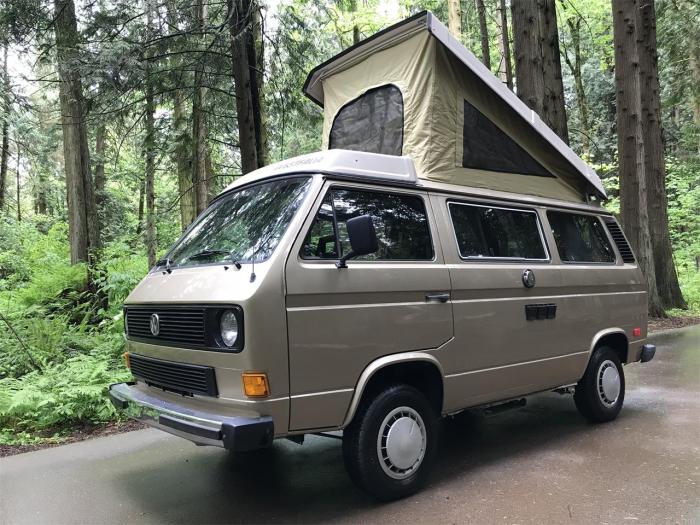
The 1985 Volkswagen Vanagon, a symbol of the era’s love for adventure and practicality, featured a distinctive design that set it apart from the crowd. Its boxy shape, sliding doors, and pop-up roof not only offered ample space but also created a unique aesthetic that appealed to those seeking a vehicle that was both functional and stylish.
The 1985 Volkswagen Vanagon, with its iconic pop-up roof and spacious interior, was a symbol of freedom and adventure. While the Vanagon offered a practical and versatile option, the iconic design of the 1961 Volkswagen Beetle still resonated with a generation.
The Beetle’s simplicity and affordability made it a cultural icon, and its legacy continues to influence car design today. The Vanagon, though a different breed, captured the same spirit of individuality and adventure, making it a beloved vehicle for those seeking a unique and reliable ride.
Exterior Design
The Vanagon’s exterior design was characterized by its boxy shape, which maximized interior space while maintaining a compact footprint. The sliding doors on both sides provided easy access to the spacious interior, while the pop-up roof added extra headroom and a sense of openness.
The Vanagon’s distinctive front grille, with its horizontal chrome bars and integrated headlights, contributed to its unique and instantly recognizable look. The high roofline and large windows offered excellent visibility, making it a pleasure to drive in various conditions.
The 1985 Volkswagen Vanagon, with its iconic boxy design and air-cooled engine, was a true testament to German engineering. While it might not have been the fastest car on the road, it was known for its reliability and spacious interior, making it a popular choice for families and adventurers.
In contrast, the 1972 Volkswagen Super Beetle was a smaller, more compact car, focusing on affordability and fuel efficiency. Both vehicles, however, shared the same dedication to simplicity and practicality that made Volkswagen a household name.
Interior Layout and Features
The interior of the 1985 Vanagon was designed with versatility in mind. Its spacious cabin could be configured to accommodate a variety of needs, from transporting passengers to hauling cargo. The removable seats, folding tables, and ample storage space allowed for customization, making the Vanagon an ideal choice for families, adventurers, and those seeking a vehicle that could adapt to their lifestyle.
The interior featured durable materials and a simple, functional design, reflecting the Vanagon’s focus on practicality.
Engine Options, 1985 Volkswagen Vanagon
The 1985 Vanagon offered a range of engine options, each catering to different performance and fuel efficiency needs. The standard engine was a 1.6-liter four-cylinder gasoline engine, providing adequate power for everyday driving. For those seeking more power, a 1.9-liter diesel engine was also available, offering improved fuel efficiency and torque.
The Vanagon’s engine options provided a balance between performance and practicality, making it a versatile vehicle for a variety of uses.
Driving Experience
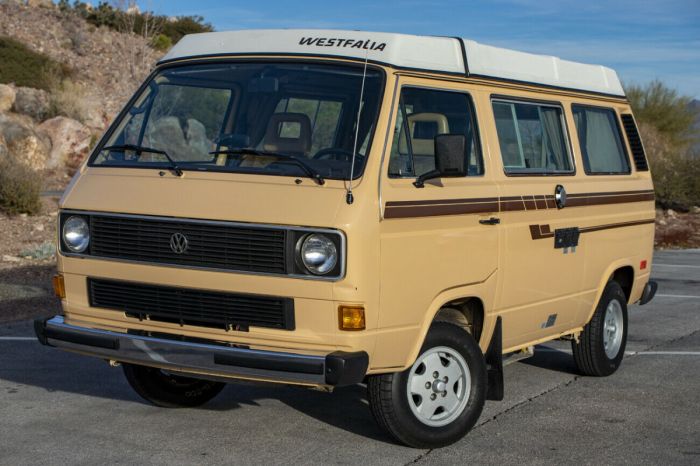
The 1985 Vanagon, despite its charming retro design, offered a driving experience that was a stark contrast to the modern vehicles of its time. Its handling, acceleration, and braking were all influenced by its unique air-cooled engine and overall construction.
Air-Cooled Engine Characteristics
The Vanagon’s air-cooled engine, a hallmark of Volkswagen’s engineering, brought a distinct set of characteristics to the driving experience. While it provided a unique sound and a sense of classic Volkswagen charm, it also presented some limitations.
- Unique Sound:The distinctive “boxer” engine sound, with its rhythmic thump, added a nostalgic element to the driving experience, making it instantly recognizable.
- Air-Cooled Advantages:Air-cooled engines were known for their simplicity, durability, and ability to operate in extreme temperatures. They were also less prone to overheating compared to water-cooled engines, especially in demanding conditions.
- Air-Cooled Disadvantages:However, air-cooled engines were also known for their lower power output, slower acceleration, and increased noise levels. They were also more susceptible to dirt and debris, requiring regular maintenance and cleaning of the cooling fins.
Handling and Acceleration
The Vanagon’s handling was characterized by its relatively high center of gravity, making it susceptible to body roll in corners. Its acceleration was also modest, especially when loaded with passengers and cargo.
- High Center of Gravity:The Vanagon’s boxy shape and elevated roofline resulted in a high center of gravity, which contributed to a noticeable amount of body roll during cornering. This could make the Vanagon feel less stable and responsive compared to more modern vehicles with lower centers of gravity.
- Moderate Acceleration:The air-cooled engine, while reliable, was not known for its power. The Vanagon’s acceleration was relatively slow, especially when fully loaded. This was a significant consideration for drivers who needed to merge onto highways or accelerate quickly in traffic.
Braking Performance
The Vanagon’s braking system was generally adequate for its time, but it could feel less responsive and require more pedal pressure compared to modern vehicles with more advanced braking technologies.
- Adequate Braking:The Vanagon’s braking system was functional, but it lacked the stopping power and responsiveness of modern disc brakes. The brake pedal felt somewhat soft and required more effort to bring the vehicle to a stop, especially at higher speeds.
- Drum Brakes:The Vanagon’s rear brakes were drum brakes, which were less efficient than disc brakes in terms of stopping power and fade resistance. This could lead to longer stopping distances and a less confident braking experience, especially in emergency situations.
Reliability and Maintenance
The Vanagon’s air-cooled engine was known for its durability and reliability, but it also required regular maintenance to keep it running smoothly.
- Engine Durability:The air-cooled engine, with its simple design, was generally reliable and could last for many years with proper maintenance. However, it was important to adhere to regular service intervals and address any potential issues promptly to prevent more serious problems.
- Maintenance Requirements:Air-cooled engines required regular cleaning of the cooling fins, oil changes, and other maintenance tasks. The engine also needed to be checked for leaks, as the seals and gaskets could wear over time. Neglecting these maintenance tasks could lead to engine overheating, reduced performance, and potential damage.
Comparison to Other Vehicles of the Era
Compared to other vehicles of the same era, the Vanagon stood out as a unique and quirky offering. Its air-cooled engine, spacious interior, and retro design set it apart from the more conventional minivans and station wagons of the time.
- Unique Offering:The Vanagon offered a distinct driving experience compared to other vehicles of its era. Its air-cooled engine, quirky design, and spacious interior made it a popular choice for those seeking a different kind of vehicle.
- Spacious Interior:The Vanagon’s interior was renowned for its spaciousness, offering ample room for passengers and cargo. This made it a practical choice for families, campers, and those who needed to transport large items.
- Retro Design:The Vanagon’s retro design, with its rounded body and classic Volkswagen styling, appealed to those who appreciated its unique aesthetic and nostalgic appeal. It stood out from the more angular and modern designs of other vehicles of the time.
The Vanagon’s Evolution
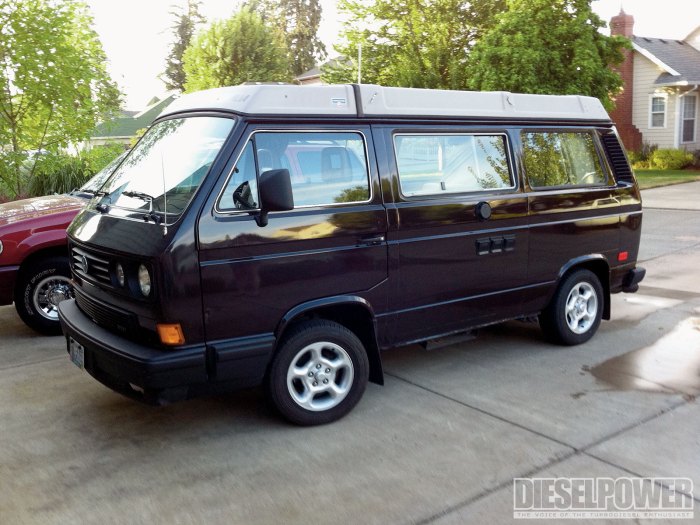
The Volkswagen Vanagon, a successor to the iconic Transporter (T2) model, underwent several changes throughout its production run from 1980 to 1992. These updates aimed to improve its performance, features, and appeal to a wider audience. While the Vanagon remained true to its roots as a versatile and reliable van, its evolution reflects the changing automotive landscape of the time.
Model Years and Updates
The Vanagon’s evolution can be traced through its different model years, each bringing subtle or significant changes to the vehicle.
- 1980-1983:The initial years of the Vanagon saw the introduction of the 1.6-liter and 1.9-liter gasoline engines, along with a diesel option. The interior featured a dashboard with a center-mounted speedometer and a minimalist design. The Vanagon’s early years were marked by its rugged and utilitarian nature, attracting families and adventurers seeking a reliable and spacious vehicle.
- 1984-1987:This period saw the introduction of the water-cooled 1.9-liter gasoline engine, which replaced the air-cooled engines of the previous models. This update improved fuel efficiency and reduced engine noise. The Vanagon’s design also saw minor refinements, including updated bumpers and a more refined interior.
- 1988-1992:The final years of the Vanagon saw the introduction of the 2.1-liter gasoline engine, offering more power and torque. The Vanagon’s interior received a more modern update, with a redesigned dashboard and a more ergonomic layout. However, the Vanagon’s production ended in 1992, paving the way for the Eurovan.
Reasons for Discontinuation and Replacement
The discontinuation of the Vanagon was primarily due to a combination of factors, including:
- Stricter Emission Regulations:The Vanagon’s air-cooled engines struggled to meet increasingly stringent emissions regulations, making it difficult to comply with new standards. The transition to water-cooled engines, while improving performance, still faced challenges in meeting these regulations.
- Safety Concerns:The Vanagon’s design, with its high roof and relatively lightweight construction, faced criticism regarding its safety performance in crash tests. Modern safety standards were becoming more stringent, prompting Volkswagen to consider a more modern and safer design.
- Changing Consumer Preferences:By the late 1980s and early 1990s, consumer preferences were shifting towards more modern and spacious vehicles with a focus on comfort and features. The Vanagon, while reliable and practical, began to feel dated in comparison to its competitors.
The Vanagon’s Lasting Appeal
Despite its discontinuation, the Vanagon continues to hold a special place in the hearts of enthusiasts. Its simple design, reliability, and versatility have made it a popular choice for campers, adventurers, and families.
- Nostalgia and Simplicity:The Vanagon evokes a sense of nostalgia for a simpler time, when driving was more about the journey than the destination. Its minimalist design and straightforward mechanics appeal to those who value simplicity and reliability.
- Versatility and Adaptability:The Vanagon’s spacious interior and removable seats offer unparalleled versatility, making it ideal for camping, hauling cargo, or even converting into a mobile home. Its rugged construction and off-road capabilities make it a popular choice for adventurers.
- Community and Culture:The Vanagon has fostered a strong community of enthusiasts who share a passion for the vehicle. Online forums, social media groups, and events dedicated to the Vanagon allow owners to connect, share knowledge, and celebrate the vehicle’s unique heritage.
The Vanagon Community
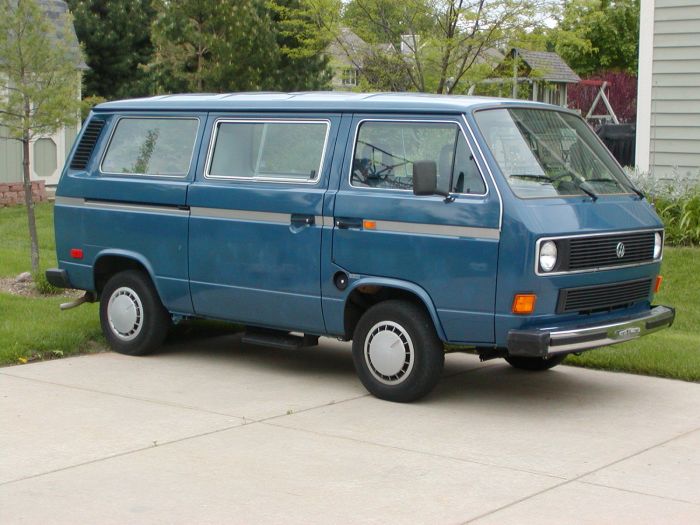
The Vanagon has fostered a vibrant and passionate community of owners and enthusiasts, united by their love for this iconic vehicle. These individuals share a deep appreciation for the Vanagon’s unique design, versatility, and the sense of adventure it embodies.
The community thrives on sharing knowledge, experiences, and a collective desire to keep these vehicles on the road for generations to come.
Online Forums and Clubs
The Vanagon community has a strong online presence, with dedicated forums and social media groups serving as central hubs for information exchange and connection. These platforms provide a space for owners to discuss everything from routine maintenance and repairs to elaborate restoration projects.
Some prominent online forums include:
- The Samba:This forum is a cornerstone of the Vanagon community, offering a wealth of technical information, parts resources, and a lively discussion board. The Samba is known for its extensive knowledge base, detailed repair guides, and a helpful community of experienced Vanagon owners.
- Vanagon.com:Another popular forum, Vanagon.com, provides a dedicated space for Vanagon owners to connect, share experiences, and seek advice. The forum features a wide range of topics, including maintenance, repairs, modifications, and travel stories.
- Facebook Groups:Numerous Facebook groups cater specifically to Vanagon owners, offering a platform for sharing photos, travel adventures, and connecting with fellow enthusiasts. These groups often organize local meetups and events, fostering a sense of camaraderie among members.
Beyond online platforms, the Vanagon community thrives on real-world connections. Numerous clubs and organizations are dedicated to preserving and promoting the Vanagon. These groups often host rallies, meetups, and events where owners can gather, share their passion, and learn from each other.
Resources for Vanagon Owners
The Vanagon community has developed a robust ecosystem of resources to support owners in maintaining, restoring, and enjoying their vehicles. These resources include:
- Repair Manuals:Several comprehensive repair manuals are available for Vanagon owners, providing detailed instructions and diagrams for various maintenance and repair procedures. These manuals are essential for both novice and experienced mechanics, offering guidance on everything from basic maintenance to complex engine overhauls.
- Parts Suppliers:A network of specialized parts suppliers caters specifically to the Vanagon community. These suppliers offer a wide range of original and aftermarket parts, ensuring owners can find the necessary components to keep their vehicles running smoothly. Some notable parts suppliers include:
- GoWesty:This company specializes in Vanagon parts, offering a comprehensive catalog of original equipment and aftermarket components. GoWesty also provides technical support and repair services, making them a valuable resource for Vanagon owners.
- Vanagon Parts Depot:Another dedicated Vanagon parts supplier, Vanagon Parts Depot, offers a wide selection of parts, including engine components, suspension parts, and interior accessories.
- Restoration Services:For owners looking to restore their Vanagon to its former glory, specialized restoration services are available. These services offer a range of options, from basic repairs to complete overhauls, ensuring that even the most challenging restoration projects can be undertaken.
Vanagon Culture
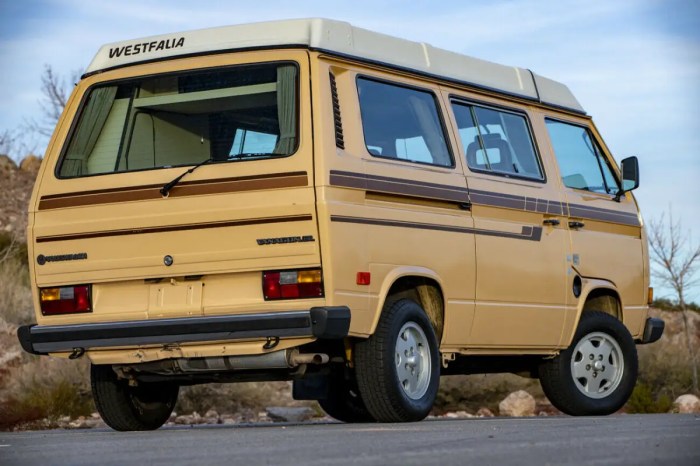
The Volkswagen Vanagon, with its distinctive boxy shape and timeless appeal, has transcended its status as a mere vehicle to become a cultural icon. It has ingrained itself in the fabric of society, leaving an indelible mark on movies, television shows, music, and the very spirit of adventure.
The Vanagon’s Role in Popular Culture
The Vanagon’s association with counterculture, adventure, and freedom is deeply rooted in its design and purpose. It embodies the spirit of exploration and self-sufficiency, offering a canvas for personal expression and a gateway to the open road. Its versatility and reliability made it a favorite among surfers, artists, musicians, and anyone seeking to break free from conventional norms.
- Counterculture Symbol:The Vanagon’s association with counterculture is evident in its appearance in films like “Fast Times at Ridgemont High” (1982), where it serves as a symbol of youthful rebellion and nonconformity. The vehicle’s association with the free-spirited, independent lifestyle of the 1980s made it a favorite among those seeking to live outside the mainstream.
- Adventure Vehicle:The Vanagon’s ruggedness and spacious interior made it a natural choice for adventurers. From road trips across the American West to expeditions to remote corners of the world, the Vanagon provided a reliable and comfortable home on wheels. Its ability to handle diverse terrains and weather conditions solidified its reputation as a vehicle capable of taking its owners anywhere they dared to go.
- Symbol of Freedom:The Vanagon’s association with freedom is evident in its popularity among musicians and artists. Its ability to transport instruments, equipment, and a band’s entire entourage made it a valuable tool for touring musicians. The Vanagon became a symbol of the nomadic lifestyle, representing the freedom to travel and create without constraints.
Memorable Vanagon Journeys and Experiences
The Vanagon’s unique character has inspired countless memorable journeys and experiences. From cross-country road trips to off-grid adventures, the Vanagon has been a faithful companion to countless individuals and families. Its reliability, versatility, and sense of community have fostered a deep connection between owners and their vehicles.
- The Vanagon Family:The Vanagon’s spacious interior and comfortable accommodations made it a popular choice for families. Many families have used the Vanagon for road trips, vacations, and even as their primary mode of transportation. The Vanagon’s ability to accommodate a family’s needs while offering a sense of adventure made it a beloved vehicle for generations.
The 1985 Volkswagen Vanagon, with its iconic pop-up roof and air-cooled engine, was a symbol of freedom and adventure. But for those seeking a more practical and fuel-efficient option, the 1992 Volkswagen Rabbit offered a reliable and affordable alternative.
While the Vanagon was perfect for road trips and camping, the Rabbit was designed for everyday driving and urban commuting, a testament to Volkswagen’s versatility in the 1980s and 1990s.
- The Vanagon Community:The Vanagon’s enduring popularity has fostered a strong and supportive community of owners. Online forums, social media groups, and local meetups provide a platform for owners to share their experiences, tips, and knowledge. This sense of community has helped to keep the Vanagon alive and thriving, ensuring that its legacy continues for years to come.
Investing in a Vanagon
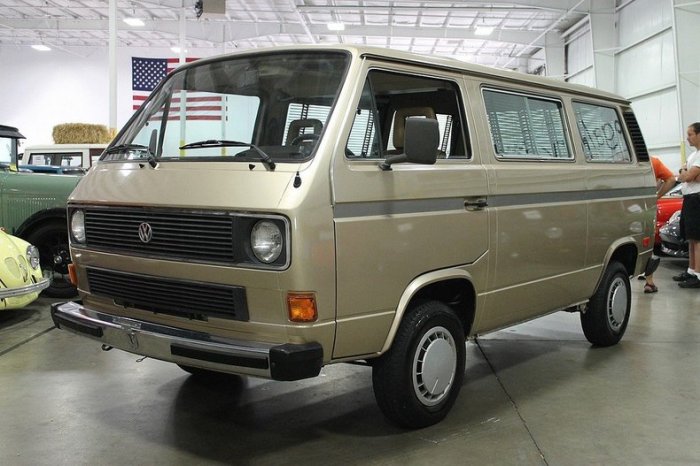
The allure of owning a Vanagon is undeniable, but it’s crucial to approach the investment with a realistic perspective. Like any vintage vehicle, the Vanagon presents unique challenges and rewards, requiring careful consideration before taking the plunge.
Factors to Consider When Buying a Vanagon
Before embarking on your Vanagon search, understanding the key factors influencing its condition, value, and future ownership costs is paramount.
- Condition:The condition of a Vanagon is the most significant factor determining its value. A meticulously maintained Vanagon with a comprehensive service history will command a higher price than one needing extensive repairs. A thorough inspection by a qualified mechanic is highly recommended before making a purchase.
- Mileage:While mileage alone doesn’t always tell the whole story, it provides a valuable indication of the vehicle’s overall use and potential wear and tear. A Vanagon with lower mileage generally indicates less wear on its components and potentially fewer repairs in the future.
However, a high-mileage Vanagon that has been well-maintained can still be a reliable investment.
- Price:Vanagon prices vary widely depending on condition, mileage, and location. Researching comparable models in your area can help you determine a fair market value. It’s important to be realistic about your budget and avoid overpaying for a Vanagon that requires significant repairs.
Finding a Reliable Vanagon
Finding a reliable Vanagon requires diligence and patience.
- Online Marketplaces:Websites like Craigslist, Facebook Marketplace, and specialized forums dedicated to Vanagons are excellent starting points for your search. Be sure to thoroughly vet any potential sellers and request detailed information about the vehicle’s history and maintenance records.
- Vanagon Clubs and Forums:Joining Vanagon clubs and forums can connect you with enthusiasts and experts who can provide valuable insights and guidance. These communities often have classified sections where members list their Vanagons for sale, potentially offering a more reliable source of vehicles.
- Professional Inspections:Always have a qualified mechanic inspect any Vanagon you’re considering purchasing. This will help you identify any potential issues that may not be immediately apparent and provide you with a better understanding of the vehicle’s overall condition.
Potential Costs Associated with Owning a Vanagon
Owning a Vanagon, like any vintage vehicle, comes with potential costs that extend beyond the initial purchase price.
- Repairs:Vanagons are known for their unique mechanical quirks and require specialized knowledge for repairs. Expect to encounter occasional repairs, especially if the vehicle has high mileage or has been neglected.
- Parts:Sourcing parts for a Vanagon can be challenging due to its age. While some parts are still readily available, others may require searching through specialized vendors or online marketplaces. Expect to pay a premium for certain parts, especially those that are no longer manufactured.
- Insurance:Insurance premiums for a Vanagon can vary depending on factors such as your location, driving history, and the vehicle’s value. Be sure to shop around for competitive quotes and consider comprehensive coverage to protect your investment.
Final Conclusion: 1985 Volkswagen Vanagon
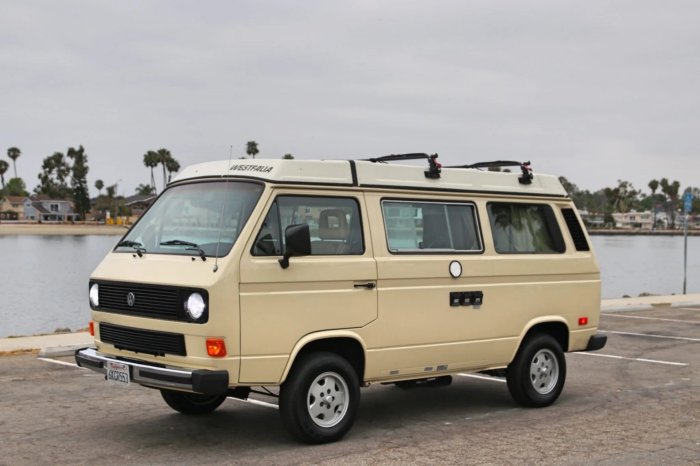
Today, the 1985 Volkswagen Vanagon remains a cherished classic, its legacy enduring in the hearts of enthusiasts and collectors. Its timeless design, rugged reliability, and undeniable charm continue to inspire a vibrant community of owners who share a passion for this iconic vehicle.
The Vanagon’s story is a testament to the power of a well-designed vehicle to capture the imagination and create lasting memories.